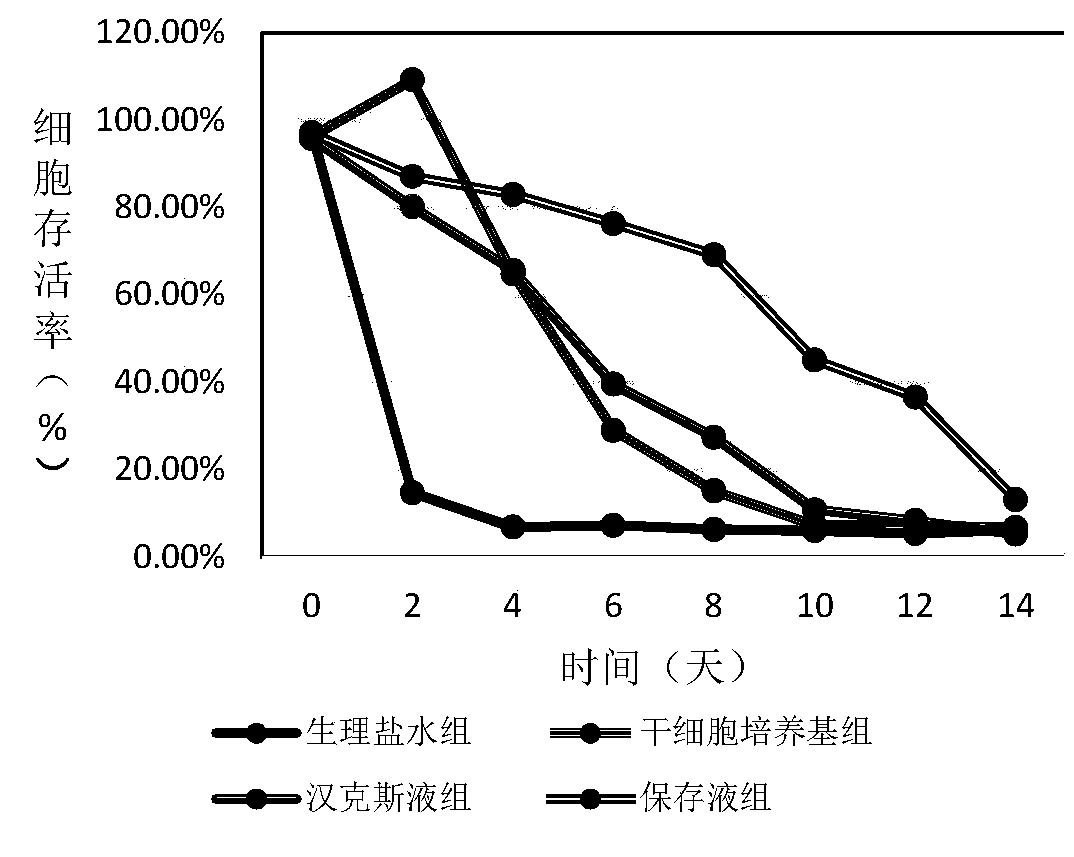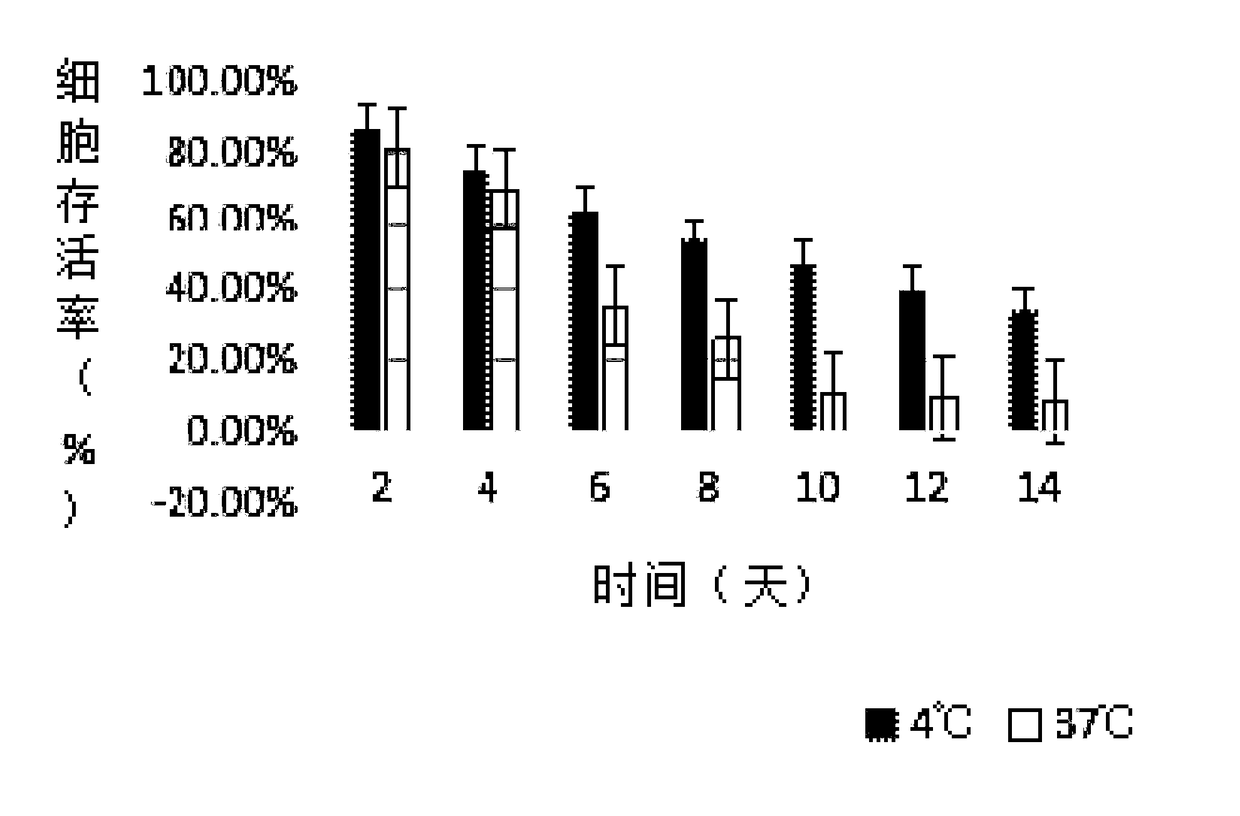Low-temperature storage liquid for cells, sodium alginate gel, cell gel, preparation method, use method and application thereof
A low-temperature preservation and sodium alginate technology, which is applied in the field of cell preservation and regeneration and repair technology, can solve problems such as affecting experimental or clinical effects, rapid decline in cell activity, and difficulty in activation, so as to facilitate subsequent application, maintain cell activity, The effect of maintaining stability
- Summary
- Abstract
- Description
- Claims
- Application Information
AI Technical Summary
Problems solved by technology
Method used
Image
Examples
Embodiment 1
[0044] The purpose of this embodiment is to screen the viscosity of sodium alginate.
[0045] Sodium alginate powder commonly used in the market is divided into three types: high viscosity (300-500CPS), medium viscosity (100-300 CPS) and low viscosity (50-100CPS). Mix high-viscosity, medium-viscosity and low-viscosity sodium alginate powders into 5% sodium alginate solutions with physiological saline, sterilize under high pressure steam at 121°C for 25 minutes, add 1% calcium chloride solution for cross-linking, and compare the three Clarity, viscosity and hardness of the gel formed by sodium alginate. Judging method: ++++ means good, +++ means medium, ++ means average, + means poor, and the follow-up screening experiment is the same. The results are shown in Table 1.
[0046] Table 1
[0047]
[0048] It can be seen from Table 1 that the high-viscosity sodium alginate cross-linked gel has the best viscosity and hardness, medium transparency, and moderate overall ...
Embodiment 2
[0050] The purpose of this example is to screen the concentration of sodium alginate.
[0051] Add high-viscosity sodium alginate powder into physiological saline to prepare 1%, 2%, 3%, 4%, 5% sodium alginate solution, sterilize by high-pressure steam at 121°C for 25 minutes, add 1% calcium chloride solution for cross-linking , to compare the transparency, viscosity and hardness of gels cross-linked with different concentrations of sodium alginate solutions. The results are shown in Table 2.
[0052] Table 2
[0053]
[0054] It can be seen from Table 2 that the viscosity of the gel formed by the cross-linking of 1% sodium alginate solution is low, and the degree of cross-linking is not enough; the hardness of sodium alginate above 4% is too high, and the cross-linking is too high; 2% and 3% sodium alginate solution The texture of the gel formed by cross-linking is moderate, so it can be seen that the optimum concentration of sodium alginate is 2% to 3%.
Embodiment 3
[0056] The purpose of this embodiment is to screen the concentration of calcium chloride.
[0057] High-viscosity sodium alginate powder was used to prepare a 3% sodium alginate solution, and sterilized by high-pressure steam at 121° C. for 25 minutes. The optimal osmotic pressure range of the solution during cell culture is 290mmol / L-310mmol / L, the calcium ion concentration is 1.8-2.8mmol / L, and the chloride ion concentration is 130-160mmol / L. In order to reduce the influence of the calcium chloride used for cross-linking on the osmotic pressure as much as possible, an equal volume of calcium chloride solution with a concentration of 0.2%, 0.4%, 0.6%, 0.8% and 1.0% was set for cross-linking according to the calculation. Determine the optimum calcium chloride solution concentration for crosslinking. The cross-linking situation of different calcium chloride concentrations is shown in Table 3.
[0058] table 3
[0059] Calcium chloride concentration
[0060] It can ...
PUM
 Login to View More
Login to View More Abstract
Description
Claims
Application Information
 Login to View More
Login to View More - R&D
- Intellectual Property
- Life Sciences
- Materials
- Tech Scout
- Unparalleled Data Quality
- Higher Quality Content
- 60% Fewer Hallucinations
Browse by: Latest US Patents, China's latest patents, Technical Efficacy Thesaurus, Application Domain, Technology Topic, Popular Technical Reports.
© 2025 PatSnap. All rights reserved.Legal|Privacy policy|Modern Slavery Act Transparency Statement|Sitemap|About US| Contact US: help@patsnap.com



